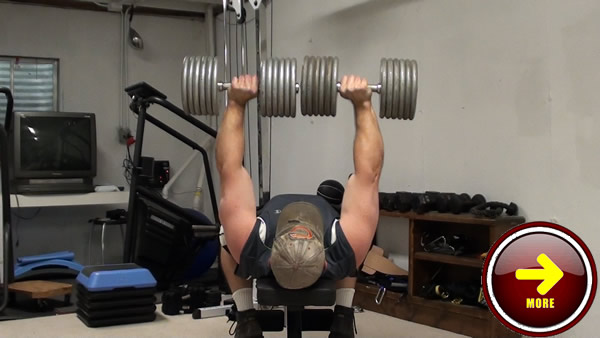Lactate Tolerance Training For Chest
Metabolic Monster Workout
This is going to BURN...
- Massive Lactic Acid/Lactate burn for Growth Hormone boost and stubborn fat loss
- Uses standard gym equipment (bench, dumbbells and barbell)
- Done in about 7-9 minutes
- Trains your body to function with high levels of circulating lactate, which is critical for athletes
- Incredible chest pump

"Feel the Burn"...that phrase actually IS for real if you want to lose fat.
However, it's not because Lactic Acid (lactate) is actually burning fat directly or even because you're burning calories from the training itself.
We want to feel that burn because of Growth Hormone...one of the most potent fat-burning and muscle-sparing hormones your body produces. The presence of Lactic Acid (and the resulting drop in pH in your body) is a powerful stimulator of GH secretion.
When you're trying to lose fat (or build muscle without gaining fat), you want as much GH floating around in your system as you can possibly get. That GH boost is the purpose of training for Lactic Acid, and THAT is what this training protocol is designed to maximize.
The goal here is to generate as much Lactic Acid as you can, then KEEP it there for a long stretch of time...in this case, 7-9+ minutes.
This requires strategy in order for your muscles to actually keep functioning with that much Lactic Acid in them. We're really going to test how much Lactic Acid your body can tolerate...and TRAIN it's ability to deal with it.
Side Note: be sure to do this training FASTED...don't eat anything within 2-3 hours before the workout, minimum. GH and insulin don't get along and elevated insulin levels will dampen the GH response we're looking for.
Let It Burn...
You can do this training on one bench, with just a few weights, so it could actually be done in a crowded gym, as long as you can grab a bench and a few dumbbells for about 10 minutes.
First, grab a moderately-heavy set of dumbbells that you can do flat bench press with for at least 15 to 20 or more reps. I'm using a pair of 75 lb dumbbells here. You will also need a lighter set that are about half that weight (I'm using 35's for the second part).

Lie back and crank out as many reps as you can get with those.


And when I say "crank out," I DO mean crank out. These should be fairly fast, powerful reps with no real focus on developing tension in the muscles...just on the goal of getting lots and lots of reps.
The idea is to generate as much Lactic Acid as you can with the moderately-heavy weight. I call this the "power start."
By the time you get towards the end of the set, you should be GRINDING the reps out, still trying to go fast, but not really being able to. Don't go to complete failure but get close. The goal here is to fail because of Lactic Acid build-up (chemical), not muscle fiber failure.
Set the dumbbells down then rest 20 seconds. This allows some of the Lactic Acid to be cleared from your muscles (not much, trust me) so that you can continue.
Pick up your lighter dumbbells. They should be about half the weight of the first set. I'm using a pair of 35's, which are a little less than half.
Whereas the first set was about power and cranking out reps, THIS set is completely focus on continuous tension in the pecs. DO NOT lockout and DO NOT stop moving the weight. Focus on keeping tension in the pecs throughout the exercise.
The movement itself should be a very even, deliberate tempo (equal time on the up and down phases) with no pauses at the top or bottom...almost robotic and piston-like.

As you come up, don't bring the dumbbells together at the top. Keep tension on the pecs by stopping the movement short of that point.

As you get towards the end of this set, the muscle tension should be extremely high and the Lactic Acid build-up should be almost unbearable, even though the resistance itself is small.
This continuous tension "lockdown" technique prevents a good portion of the Lactic Acid (and other waste products) from being cleared from the pecs. If you're familiar with "Occlusion Training," this is exactly the same thing, only done on the big muscles of the torso that can't be tied off.
Side note: Occlusion Training is where you tie a band or strap around your limbs near the joint (arms or legs) to slow down (occlude) return blood flow from carrying waste products out of the muscles. It's not tight enough to cut off inwards circulation...just outwards. Trapped waste products are a potent stimulator of anabolic hormones.
Perform reps until Lactic Acid shuts you down. Literally, I mean that. Perform reps until you don't have enough control over your arms to keep performing the exercise safely.
Set the weights down and rest 20 seconds then go again with the same rep style and goal (continuous tension to trap Lactic Acid in the muscles).
Set the weights down, rest 20 seconds, then repeat one more time for a total of 3 "light" sets after the 1 "power start" set.
Now comes the Stability Drop portion of our festivities...
There is a continuum of stability in different exercises...dumbbells are the least stable, then barbells then machines.
We started with the most unstable version of the bench press here on purpose.
Because after you burn out with the dumbbells, after 20 seconds rest, you're going to go immediately BACK to the "power start" style of set only with BARBELL bench press...using the exact same weight you did the first power start set with dumbbells with.
For me, this was 150 lbs on the bar (make sure you have that pre-set and ready to go).
You likely won't get as many reps as the first set, but you will get a decent amount (I think I got 11), simply because that barbell version is more stable than the dumbbell version and those stabilizing muscles (which are fatigued and swimming in Lactic Acid right now) won't be called upon as strongly.
Crank out as many reps as you can with that weight, going for power and fast reps (no bouncing off the chest).


When you're completely toasted, quickly reduce the weight by half (if you have a spotter to help, even better...if not, just go as fast as you can), then go again.

The weight is extremely light to the point of being ridiculously light if you were doing "normal" training. This is 75 lbs on the bar for me.
The weight won't be challenging but performing reps with the sheer amount of localized Lactic Acid WILL be challenging.
Again, this is continuous tension, no lockout training, so don't crank out reps...go for feel and tension, making sure you keep that Lactic Acid locked into the muscles.


Towards the end of the set, you will again feel like you're going to lose control of your limbs. That's when you rerack the bar, rest 20 seconds then do another set. Then rest 20 seconds and perform one final set.
At this point, your chest will be extremely pumped up and probably twitching to some degree.
You will have flooded your chest with Lactic Acid for a solid 7-9 minutes or more, which should give you a nice boost in GH, especially when you continue this training for back and for legs (found in the full Metabolic Monsters book).
All you need is ONE round through this and you're done for chest.
If You Have Access to a Bench Press Machine
You can take this "stability drop" concept one more step further if you have a bench press machine you can use. Machines introduce one more level of stabilization into the mix.
After finishing your light sets of barbell bench press, perform the same method (same weight "power start" set then drop the weight by half and perform light, continuous-tension sets) on the machine.
If you DO have the machine, do just 2 sets of light training instead of 3 for each level of stability.
Here's an Overview of The Workout:
Part 1 - Dumbbell Bench Press - Moderate Weight - 20+ reps - 1 set
- These should be fairly fast, powerful reps with no real focus on developing tension in the muscles...just on the goal of getting lots of reps (at least 20 or more on the first set, so gauge your weights accordingly).
- Rest 20 seconds
Part 2 - Dumbbell Bench Press - Light Weight (about 50% of first set) - AMRAP - 3 sets
- (AMRAP stands for As Many Reps As Possible). Go for strict form and continous tension on these reps. Perform as many reps as possible until lactate accumulation shuts you down.
- Rest 20 seconds
- Perform a total of THREE light weight sets here, taking 20 seconds rest in between sets.
- Then go to...
Part 3 - Barbell Bench Press - Same Equivalent Weight as Part 1 - AMRAP - 1 set
- Again, go for fast reps, focusing on getting as many as possible rather than on strict form.
- Rest 20 seconds. Take this time to change the weight on the bar.
Part 4 - Barbell Bench Press - Light Weight (about 50% of first set of barbell bench) - AMRAP - 3 sets
- Go for strict form and a controlled, continuous tension style of movement. You'll be performing THREE light weight sets, taking 20 seconds rest in between each set.
Download a PDF of This Workout and Four MORE Insane Workouts Like It, FREE.
Keep this workout for reference so you can print it and/or view it on your phone. Right-click here and choose "save target as" to directly download a PDF of these workouts now...

